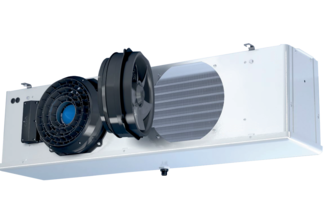SCHIESSL is ready for CO₂ (R744)
Welcome to the future of refrigeration: technology: carbon dioxide R744 (CO₂) as an alternative refrigerant.
Explore a future that focuses on environmental protection, energy efficiency and sustainability. As R744 is a new refrigerant for many, it is also important for us to be well informed on the subject and the differences to other conventional refrigerants. As a competent wholesaler, we strive to support you, clarify questions and do everything we can to ensure that your projects can be implemented safely and flawlessly in the future.
Here you can find out everything you need to know about CO₂ refrigerant, from its benefits to its applications.
Why CO₂?
The refrigerant R744 is not only an innovative choice, but also a sustainable solution for refrigeration and air conditioning systems. It offers many advantages:
- Environmentally friendly CO₂ is a natural refrigerant that has no negative impact on the ozone layer and has a low greenhouse effect. The use of CO₂ as a refrigerant actively contributes to environmental protection.
- Energy efficiency CO₂ is extremely efficient and enables significant energy savings. This leads to lower operating costs and an improved environmental footprint.
- Versatility CO₂ is used in a wide range of installations, from food refrigeration to air conditioning. The adaptability of this refrigerant makes it the ideal choice for various industries.
SCHIESSL as a competent partner
With the refrigerant R744, we as refrigeration technicians are once again faced with new challenges. Due to the high system pressure, good planning and safe working practices are very important. We are proud to be a reliable partner for CO₂ systems too. Our experts have in-depth knowledge and extensive experience in this field. Our services include:
- Consulting We consult and support you from the planning stage through to the installation of CO₂ systems to achieve optimum results.
- Products Discover our wide range of high-quality R744 compressors, refrigeration components, etc. (see below for products)
- Trainings Our training courses provide you with the know-how you need to work safely and professionally
- Technical support Our team of experts is always ready to help you with questions and problems

Our CO₂ product range
Discover our wide range of high-quality R744-powered compressors, condensing units, evaporators, refrigeration components and special refrigeration systems.
Refrigerant R744 /CO2
Semi-hermetic Compressors
Fully hermetic compressors
Condensing units
Evaporators
Schiessl multi compressor packs & special systems
An experienced team develops a variety of solutions for you based on our many years of experience, which can cover a wide range of applications. Many standard devices are available from stock or with short delivery times.
We use compressors from all leading manufacturers. We attach particular importance to reliability, which is why we only use components that fulfill our high quality standards. We are also your competent partner for future-oriented systems with natural refrigerants.
All systems are designed using the latest 3D technology. The pipe segments are transferred directly from the design department to our modern bending center and manufactured. All systems can be equipped with a variety of options. We also have a highly experienced team of electrical engineers who develop our control cabinets and they are manufactured in accordance with all current electrical and safety regulations. Find out more about our special plant construction.
Water-cooled R744 compound system
Cooling capacity:
2 × 50 kW (Te –32 °C / Tc –3 °C)
Heat transfer medium condenser:
Propylene glycol –8 °C / –4 °C
Brine piping made of welded stainless steel

Ready for CO₂?
Contact us today to find out more about R744, our products, planning and installation, etc. so that you can become a CO₂ system professional yourself in the future.
CO₂: Questions about the refrigerant and its properties
Why is CO₂ a natural refrigerant?
The refrigerant CO₂/R744 has no ozone depletion potential (ODP = 0) and an extremely low global warming potential (GWP100 = 1). Compared to R404A, it ensures greater energy savings and lower CO₂ emissions. These properties make it ideal as a natural refrigerant.
Why is CO₂ so safe?
As a non-toxic and non-flammable refrigerant, CO₂ guarantees a high level of occupational safety from commissioning to maintenance without a great deal of administrative effort. The products are stored in a safe working environment with no risk of contamination (e.g. in the event of a leak).
Why is CO₂ used as a refrigerant in commercial refrigeration solutions?
CO₂ is used as a refrigerant because of its environmental friendliness, safety, availability and energy efficiency in certain conditions.
Why is CO₂ sustainable as a refrigerant?
CO₂ is a future-proof solution for refrigeration systems. CO₂ is currently not subject to legal restrictions, taxes, price increases or shortages. This means it is not affected by foreseeable legal changes or bans. The following also applies:
- no shortage, no obsolescence
- higher return on investment thanks to EU subsidies
- Complies with the latest F-Gas Regulation and meets the efficiency requirements of the Ecodesign Directive
How efficient is CO₂ as a refrigerant compared to other refrigerants?
The efficiency of CO₂ as a refrigerant can vary, but it can be extremely efficient at lower ambient temperatures. The key to this is efficient compressor technology.
How do the environmental key figures of the refrigerants compare?
CO₂ (R744) has the best characteristics with ODP 0, GWP 1, non-flammable and non-toxic compared to the refrigerants ammonia (R717, ODP 0, GWP 0, flammable, hardly flammable and toxic) and isobutane (R600a, ODP 0, GWP 4, flammable and non-toxic).
Does CO₂ as a refrigerant meet the targets of the F-Gas Regulation?
Yes, because CO₂ has no ozone depletion potential and a GWP value of 1. It is non-toxic and naturally occurring. It falls into safety group A1.
What are the limits of use for CO₂?
Main area of application: Deep-freezing (partly cascade systems), heat pumps, mobile refrigeration systems, refrigeration systems in supermarkets, etc. The temperature spectrum ranges from +10°C to -40°C evaporation temperature.
How is the efficiency of CO₂ affected at different ambient temperatures?
CO₂ shows high energy efficiency, especially at low ambient temperatures. At higher temperatures, efficiency can decrease, but there are technologies that have been developed to overcome this challenge.
Is CO₂ toxic?
CO₂ is neither toxic nor poisonous! However, if there is a leak, the escaping CO₂ can displace the oxygen molecules (02) in the air.
Questions and answers about the practical use of CO₂ as a refrigerant
What safety guidelines must be observed?
The CO₂ concentration must be monitored by means of CO₂ measurement. MAK value (maximum workplace concentration) is 0.5 % (5000 ppm). Ice formation in pipes and hoses or on fittings is a danger to people in the immediate vicinity. As a gas, carbon dioxide is about 1.5 times heavier than air at atmospheric pressure, flows primarily downwards and can accumulate in pits, cellars and depressions in the ground, similar to propane. With weak air movement, such CO₂ accumulations can last for hours and lead to suffocation at high concentrations.
Do I need special training to work with CO₂?
CO₂ is declared as refrigerant R-744 and can therefore be filled or drained by any technician who has a personal certificate.
Can CO₂ also be used as a refrigerant in the air conditioning sector?
Areas of application include areas such as
- Refrigeration systems in food retail
- Air conditioning systems - also in the automotive sector
- Commercial refrigeration
- industrial refrigeration
- in subcritical and transcritical systems in temperature ranges from 0°C to -40°C
Do you need special certifications (e.g. brazing certification)?
Yes, refrigeration and air conditioning technicians and other mechatronics technicians with the appropriate authorization require certification if they intervene in the refrigeration circuit of a stationary refrigeration or air conditioning system. It is also called a personal certificate. Certification in accordance with DIN EN ISO 13585 is required for brazing work. Where brazing work is carried out on pressure equipment for refrigeration systems or heat pumps that fall under the Pressure Equipment Directive, certification in accordance with DIN EN 14276-1 is required. This certificate must be refreshed every 3 years by an official body. An internal inspection is carried out every 6 months.
Conclusion: CO₂ as a refrigerant
There are numerous advantages to using CO₂ as a refrigerant:
CO₂ (R744) is used in cooling systems due to its environmental friendliness (ODP 0, GWP 1), safety (non-flammable, non-toxic) and energy efficiency, especially at low temperatures. It offers a high volumetric cooling capacity with low temperature differences and pressure drops, which has a positive effect on efficiency. In addition, CO2 supports a wide range of commercial applications and is characterized by uncomplicated disposal, which benefits the environment. Last but not least, long-term availability and compliance with environmental regulations make CO₂ a future-proof choice that not only protects the environment but also meets energy efficiency and sustainability requirements.











